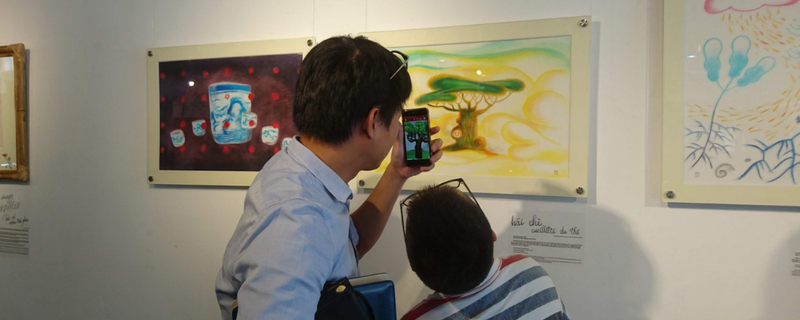One of the most fascinating elements of AR, when seen through the eyes of a creative, is how it necessarily confronts you with a whole new sense of perspective. The static becomes connected, the passive becomes interactive and the still image becomes a portal to a whole new layer of digital content.
The growing possibilities of tracking AR experiences - including image tracking and world tracking - mean that artists are confronted with a fresh digital canvas for their creations that can exist literally in the world around them. Or as our own super-talented Anna puts it...
“...you’re no longer thinking about how graphical elements will look on a page or a screen, you have to think - how will the design sit within the real world?”
- Anna Broadhurst, Senior Visual and Motion Designer
The possibilities for shaping this new era of spatial storytelling are huge - and we’ve spoken before about how creatives from backgrounds as diverse as design, illustration and 3D modeling can upskill to create immersive experiences without changing their fundamental artistic principles.
Of course, the other side of the coin is that the scope of artistic possibilities can be bewildering - after all, you have an entirely new dimension to play with! Fortunately, the Zapworks community are an incredibly talented bunch with lots of brilliant examples to help inspire you. Here’s some of our favourite ways they’ve used Zapworks to challenge expectations and change the art world.
Phuong Nguyen's 'Trà Art' exhibition showcased what AR can bring to a gallery experience, seamlessly layering digital experiences onto static imagery
AR and art
We’ve always been passionate about AR’s ability to empower people to dig deeper - to use their smartphone camera to dive headlong into an additional level of interactive content, accessed through objects and spaces in the world around them. Museums and galleries are a fantastic arena for this, with AR experiences transforming passive viewers into active participants and driving valuable conversations between visitors, artworks (and their subjects), artists and institutions alike.
AR utilizes digital space when physical space is often at a premium, enabling digital storytelling via smartphone, with creatives and curators leveraging video, animations and mini-games to communicate everything from gallery heritage, to the exploration of artistic themes to showcasing how a piece of art was conceived and constructed.
Plus, this enhanced level of storytelling is making it easier than ever for artwork to find a new home - communicating information visually to prospective buyers in an unobtrusive and flexible way on their own device. Leveraging world tracking and product visualization enables art lovers to see what a piece could look like in the context of their own home, while layered animation and video can provide a contextual artist’s commentary on the thought process behind their latest work, building and strengthening the emotional bond between the creator and their audience.
“The bottom line is that whatever combination of technologies proves most disruptive to the entrenched practices of art production and marketing, the art business needs to find ways of engaging the next generation of buyers. And these are people who must be reached in their own turf – which is bound to be predominantly digital rather than analog.”
- Alice Bonasio, Forbes

A visitor uses the Zappar app to unlock and interact with an AR experience at Bin Le's 'X,Y+Z' exhibition
AR and the new frontier of human interaction - ‘X,Y+Z’, Bin Le
A world where AR is increasingly normalized presents us with a whole host of questions about the ways we communicate with each other and how that will evolve alongside this new facilitating technology. This was an issue Baltimore-based graphic, motion & web designer Bin Le wanted to explore further with their ‘X,Y+Z’ exhibition - an interactive environment where both physical interaction and AR technology are integrated, exploring how the former is necessarily affected by the latter. This was inspired partly by the societal transition from keyboards to touch-screen tapping and how that's affected how we communicate with each other and therefore, how the new era of AR with gesture controls and camera scanning could affect human communication in the future.
“I envision a future in which human interaction (in this case, the human hand) becomes the universal input element for interacting with technology. So in this case, human physical interaction becomes a part of technological interaction. These interactions include facial expressions, tilting, tapping, gestures, and motion tracking.”
- Bin Le, artist
By adding layers of digital content to 2D and sculptural work with Zapworks Studio, Bin Le was not just creating something visually stunning. The act of scanning itself and interactions via the smartphone camera provided a controlled, real-life insight into how AR can affect how we consume, engage and communicate with both art and each other in an evolving form of immersive language.
We loved exploring Bin Le’s example in our office as it speaks to some of the core fascinating parts of AR. As the title of his exhibition cleverly implies, the X and Y ‘axis’ conveys the idea of something flat, with the arrival of a Z axis speaking of something new and augmented - a future where surfaces can become a whole digital canvas for creatives to explore!
Bin Le's 'X,Y+Z' exhibition leveraged the Zapworks toolkit to explore how new technology influences how we communicate and interact
AR storytelling and the artistic personality - ‘AR_U?’, PJAIT
The forward-thinking team of creatives of the New Media Art Department at the Polish-Japanese Academy of IT are a brilliant example of using AR to explore a whole new way of storytelling.
“When deciding on the environment for AR for the AR_U project in March 2019 I decided on Zapworks and PJAIT bought a license for me and a couple of students. I think it is a great environment, making it easy to collaborate with team management, and for rapid prototyping and easy testing.”
- Olga Wroniewicz, PJAIT
With an exhibition that sprawled through stairwells and adorned walls across campus, ‘AR_U?’ was an innovative project that explored the process of shaping the artistic personality. Using collected biographies from students across the department, Zapworks was used to create a range of context-sensitive multimedia content based around themes of the changing value of written text and identity.
While 'AR_U' currently utilizes the free Zappar app, it indicates some exciting possibilities for the integration of Zappar WebAR for sharing artistic experiences in future. As a piece of art on campus with the potential of engaging incidental visitors, the exciting ability to access AR content via the mobile web browser, without the need for a scanning app download, could make engagement even more attractive for passersby.
The 'AR_U' exhibit had students sharing their biographies through innovative AR experiences in an exploration of identity
AR enhancing the museum experience - 'The Seventh Sense' (UAL x British Museum Lates)
What happens when you bring cutting-edge immersive technology into one of the most storied museum institutions in Britain? Something curious and wonderful in turns out, as we saw in 'The Seventh Sense', an innovative collaboration between the University of the Arts London (UAL) and the British Museum.
Inspired by the work of the influential sculptor, Rodin, artists Despoina Zachariadou and Nina Montironi decided to create AR experiences to explore modern technological methods for getting audiences interacting and connecting with past artwork and historical artifacts.
Just as Rodin’s artwork was about revealing the nature and ‘true feelings’ of the subjects they depicted, the artistic duo used Zappar-powered AR to add layers of digital content onto works throughout the gallery space to create a ‘seventh sense’.
“‘The seventh sense’ depicts our idea to enhance past artwork with modern technology, expressing the old stories in their modern context and dialogue with the audience...our aim is to “create a seventh sense” to the audience, merging inspiration of the past and life of the present.”
- Despoina Zachariadou and Nina Montironi, artists
This experience also showcases an elegant use of the Zapcodes to guide visitors - pairing them with selected works in the museum’s Enlightenment Gallery as an unobtrusive way to trigger AR content. As part of a self-guided walk around the space, this created “a unique and immersive experience into how we view, observe, use and interpret art, history and modern technology”.
'The Seventh Sense' self-guided set of AR experiences highlighted new ways to explore and combine past artwork using modern technology
AR to transcend tradition - 'Trà-Art', Phuong Nguyen
One of the most fundamentally exciting things about how AR interacts with the world of art is how it can be used to allow visitors to dive deeper into an exhibition’s subject matter. We often talk about AR in terms of adding a digital layer of content, but sometimes it’s more useful to consider how AR can also remove layers - using AR as a way of disintegrating pre-conceptions about familiar or ‘traditional’ imagery and empowering the viewer to explore their hidden depths.
Phuong Nguyen, a visual development artist, 2D animator and animation generalist from Vietnam who’s currently attending the prestigious Gobelins l’Ecole de l’Image, exemplified this approach with their ‘Trà Art’ exhibition. Hosted at Insitut Français, L’Espace Hanoi and created in collaboration with 3D artist Marcus Bowler, ‘Trà Art’ portrayed the wild beauty of North Vietnam’s rich spiritual life and natural splendor through animation, drawings, comics, a tea ceremony, contemporary dance, photography, and sculptures.
What’s particularly exciting about the project is how neither artist had ever worked with AR before! Combining free 3D model software, Blender with Zapworks Studio, Phuong was able to seamlessly combine the traditional with the modern - displaying pastel drawings alongside Vietnamese folk poetry, with a Zapcode serving as a portal to reveal beautiful hidden animations.
“ The reactions from the audience were gold. At the end of the exhibition, we ended up with a total of 6784 interactions via the app, many questions and interest in the process of making the animation come to life. It was a great experience!”
- Phuong Nguyen
With content accessed via the free Zappar app, an attractive and compelling call to action was necessary for visitors to know exactly how to engage with the AR content. Phuong took one of the most innovative approaches to this we’ve ever seen - creating an amazing stop-motion instructional video, showing your smartphone turning up for the show. Check it out!
'Trà Art' took a fun and innovative approach to instructing users how to access AR content with a stop motion call to action
Final thoughts
Our Zapworks toolkit is on-hand to give intrepid creators everything you need to transform creative ideas into immersive experiences. From the drag n drop, browser-based Designer, to our fully-fledged, versatile and powerful Studio tool - our artist-friendly software can empower you to bring your existing skillset to AR and enable you to play a role in defining this new digital canvas, with or without code. We’ve got a whole range of handy walkthroughs, step-by-step guides and videos to help you on your way. Plus, the community and our expert support teams are prepped and ready on the Zapworks Forum to offer everything from in-depth feedback to that little bit of encouragement you may need to get creating. And if you’re a brand looking to activate something on a bigger scale, you can call on our talented in-house designers, developers and producers to realize your vision - simply reach out for a chat.
 James Wright
James WrightCommunity Marketing, Zappar
